Anglers Booking Team
The expert copywriters at Anglers Booking have meticulously crafted this article. Our dedicated team of writers provides valuable insights and information to enhance your angling experience.
 12 minutes read
12 minutes readGalveston, Texas, is the ultimate playground for anglers who want to try all or at least a little of everything the fishing world offers. This small town is located right on the coast of the Gulf of Mexico, and that fact alone is enough to give you an idea of what a masterful fishing treasure lies there!
Whether you're drawn to chasing hidden Redfish in the Gulf, the thrill of a hard-fighting Tarpon, or the serene catch-and-release of Speckled Trout, Galveston has it all!
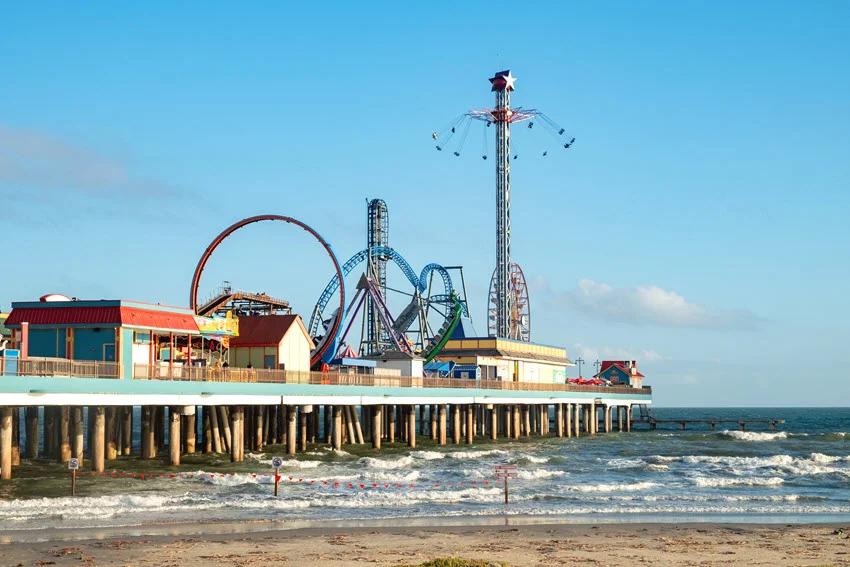
Yes, the waters are so varied, with wonderful approaches, from busy docks to quiet bays, and if you're the type who's hooked on adventure, Galveston has got your back there, too. Before you head to Galveston, take our guide as a sneak peek to discover the best spots for the species you must catch, and pick up some brilliant tips we'll throw at you along the way!
Galveston's waters are a generous fishing haven for both natives and visitors, and there's so much to choose from that there's no way you won't catch at least something. Therefore, if you need a boost or motivation to fish, Galveston will give it to you. Let's get to know some of the native and migratory fish.
Galveston's native fish species are the heart and soul of its ever-living and exceptionally active aquatic ecosystem. There are many local favorites, from goofy Flounder to robust Redfish, and the possibilities for quality fishing action are endless.
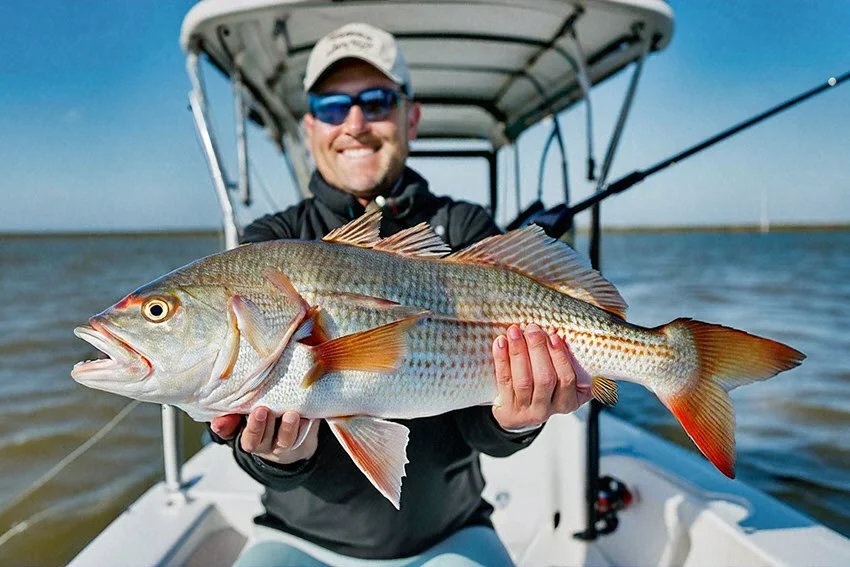
Redfish, with their vivid reddish hue and distinctive black spots, are as striking as they are elusive. Their powerful fights and impressive sizes make them a thrilling catch. Their abundance in Galveston is not decreasing. They can be found in Galveston's shallow bays, estuaries, and coastal marshes. The late summer and fall are the best times to catch them, adding to the excitement of your fishing trip.
Most anglers catch them using live bait such as shrimp or crab, and practicing techniques include sight fishing and using live bait. Redfish can be seen year-round in Galveston, but they are most active in late summer and fall. The specificity of Redfish is that, no matter how common it is, especially on the shores of the Gulf of Mexico, it is always intriguing, and its popularity never goes away.
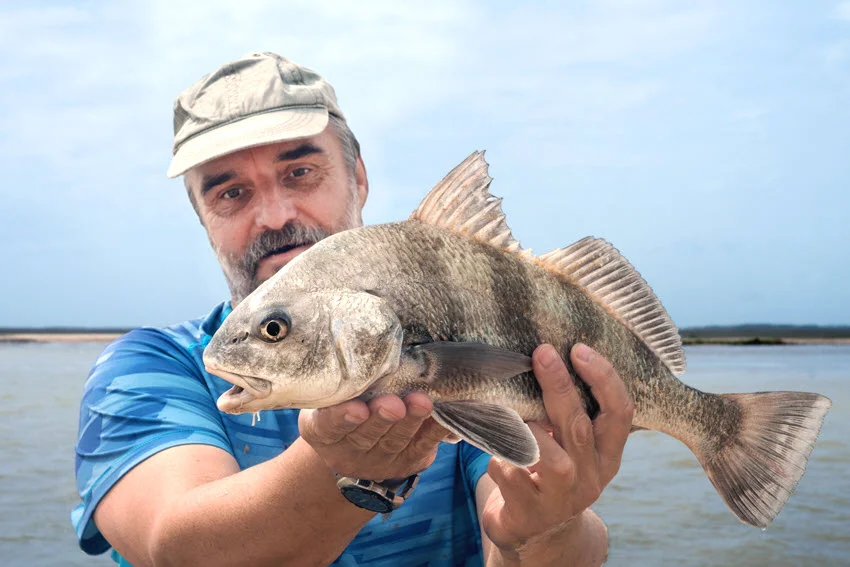
Black Drums are large fish with bodies decorated with vertical stripes and impressive sizes. Known for their powerful fights and firm, fleshy bodies, they can reach up to 60 inches, which is one of the reasons anglers love them. Black Drum usually lurks in the same shallow bays, estuaries, and coastal areas that characterize Galveston's fishing scene, preferring warm, brackish waters.
Bottom fishing techniques, using bait such as fresh crabs or shrimp, are the most common method for catching these fish. They are also known for their strong running and determined fights, which make them a profitable catch. In Galveston, Black Drum can be found year-round, but the cooler months of winter and early spring are the best times to hunt. If you like big and fat fish that do not surrender easily, Black Drum is that fish.
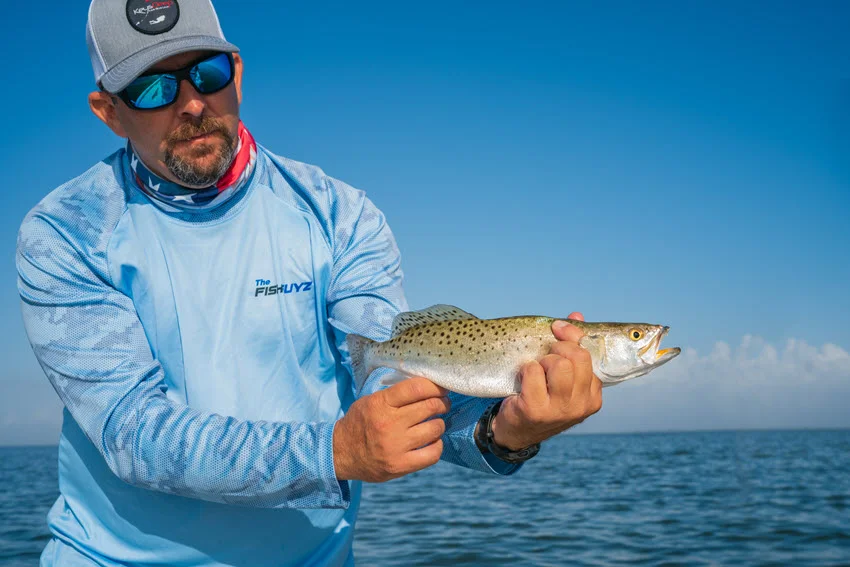
The Speckled Trout, also known as Seatrout, is a beautiful fish with an elongated and elegant body, a fantastic mixture of beauty and muscle. They can reach up to 30 inches and provide a spirited fight that will excite any angler. This fish, which prefers the warm, shallow waters of bays, estuaries, and seagrass beds, is a testament to Galveston Bay's natural beauty.
The easiest way to catch this beauty is to use live shrimp, soft plastics, or small live fish. Techniques such as throwing and returning or floating are especially effective. Like most native species, they can be fished year-round, with spring and fall being particularly productive seasons. This makes them a must-target species for anyone fishing in Galveston.
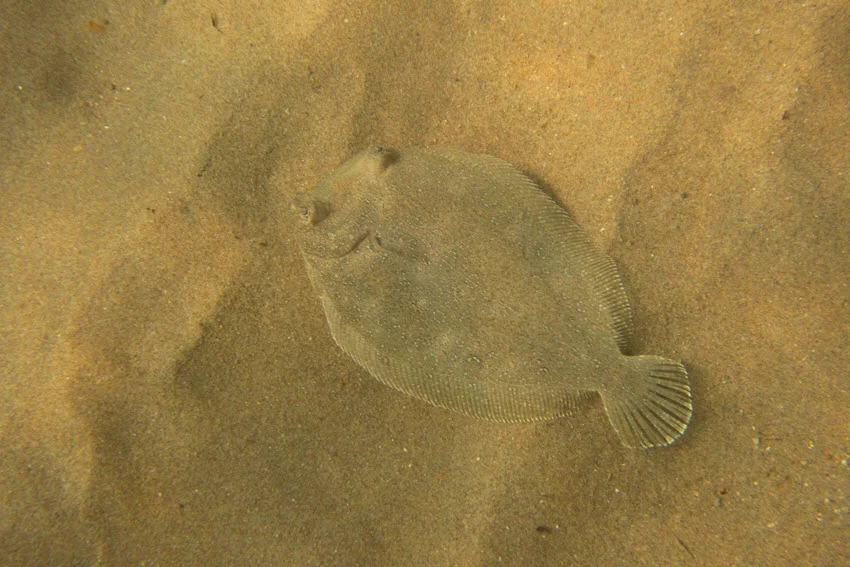
Flounder is an exciting fish celebrated for its unique flat bodies and excellent taste. Although not very large, they are elusive even with their average size of 24 inches. They are also known for their ability to fit seamlessly into the sandy or muddy bottom of bays, estuaries, and coastal waters.
They are caught using drift fishing and bottom fishing techniques, with live or cut bait fish, shrimps, or soft plastics. A popular option is flounder gigging, a method of hunting them at night with a particular spear, a unique attraction. With some luck, you can catch Flounder all year round, although fall and early winter are considered the peak fishing season for this fish.
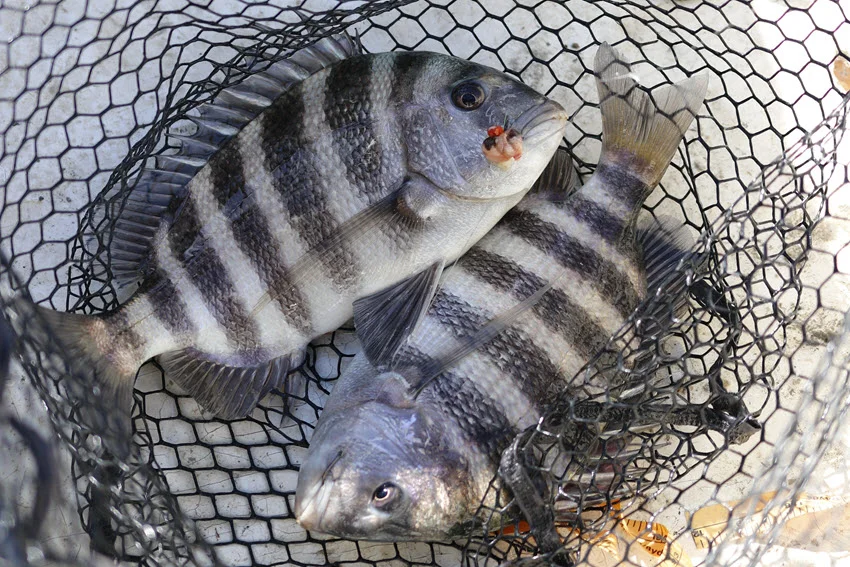
Sheepshead is an unusual-looking fish known for its striking black stripes and terrifying jaws that resemble a sheep's head, hence the name. Depending on the conditions, it can reach up to 30 inches in length. In addition to their striking head, they are easy to recognize by their sharp teeth adapted to crushing shellfish and crustaceans.
Sheepshead are primarily caught on live or cut crabs, shrimp, or clams, with bottom fishing proving the most effective technique. Galveston waters are most abundant during the colder months, winter and early spring. Sheepsheads are known to be tough fighters who will bite and attack fiercely without hesitation, so be careful.
Migratory fish species add a particular extra layer of excitement and raise the possibilities of fishing action to at least one level higher! In keeping with their nature, many pelagic fish follow their nature and seek better waters, food, or shelter, and so occasionally visit the waters of Galveston. Find out below what kind of fish they are and when they are in season in these waters.
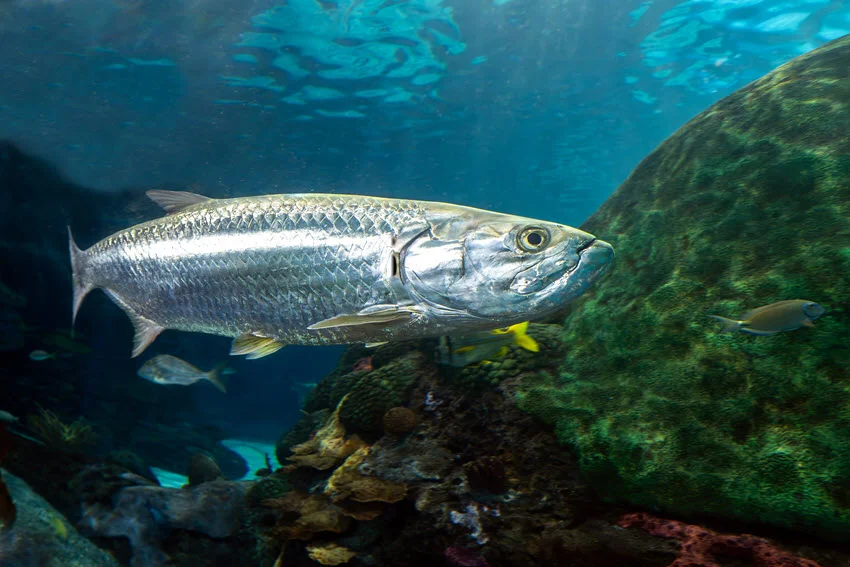
For many anglers, tarpon is one of the most prized catches and a significant trophy that proves their skill, including in Galveston. This fish is known for its impressive size and breathtaking acrobatic jumps. Called the "Silver King" for their smooth, metallic luster, they can grow up to 8 feet long and weigh over 200 pounds.
Tarpon migrate through Galveston waters, attracted by the warm temperatures and abundance of baitfish in the shallow bays and coastal areas. Anglers use live bait fish, crabs, artificial baits, and techniques like sight or drift fishing to overcome and overpower Tarpon. The thrill of the Tarpon's acrobatic leaps and powerful runs makes it a challenging and exciting catch, inspiring many anglers to set it free.
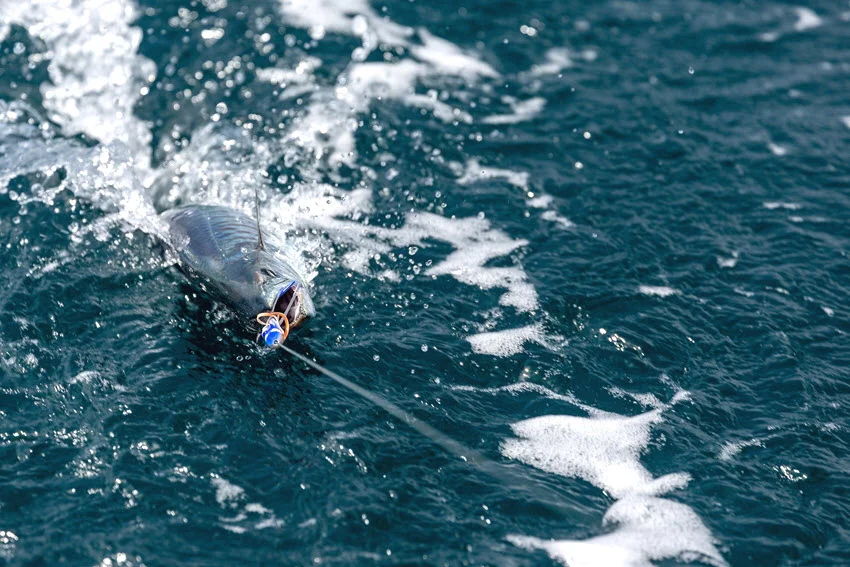
This species is often called Kingfish, and for good reason. They are assertive and combative and, therefore, frequently hunted. Kingfish have a fast, sleek, silver body that can reach lengths of up to 5 feet and weigh over 50 pounds, making them a prime target for anglers seeking an adrenaline-filled experience. King Mackerel are migratory fish that cruise Galveston's waters in search of nutrient-rich environments and abundant baitfish.
To catch King Mackerel, anglers often use live bait fish, trolling lures, shiny spoons, and trolling or fast jigging techniques near reefs and offshore structures. If you like adrenaline and excitement, King Mackerel will give you just that: a high-energy fishing experience in summer and early fall.
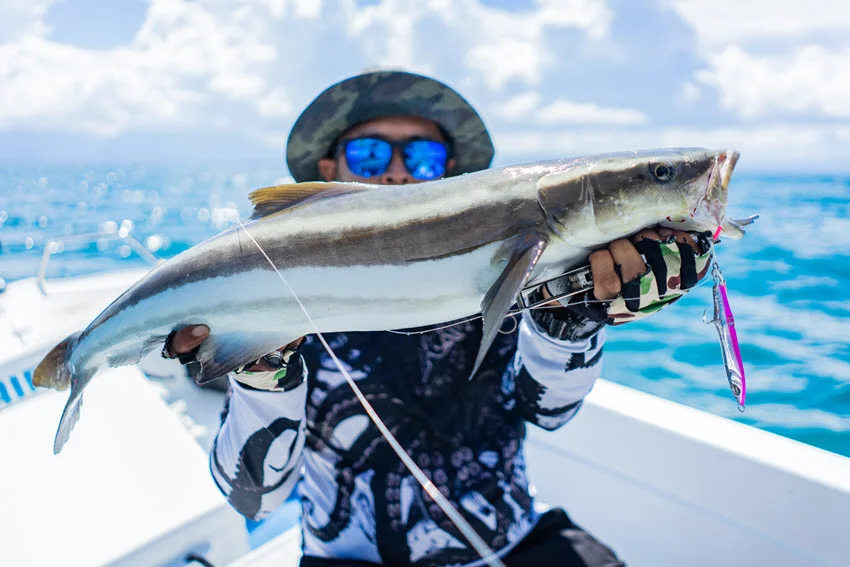
Another big game fish you can catch in Galveston waters is Cobia! This fish is known for its impressive size, fighting spirit, and excellent taste. It can grow up to 6 feet long and weigh over 100 pounds. You'll find them lurking through Galveston's waters, near buoys, oil rigs, and reefs, where they prey on smaller fish and crustaceans.
They use live bait fish or eels and techniques such as jigging, drifting, or trolling to catch them. Cautious and solitary but very combative and with very aromatic meat, it is no wonder they are one of the favorite fish. The spring and summer months offer the best opportunities to meet these impressive fish when they are most active and not so wary.
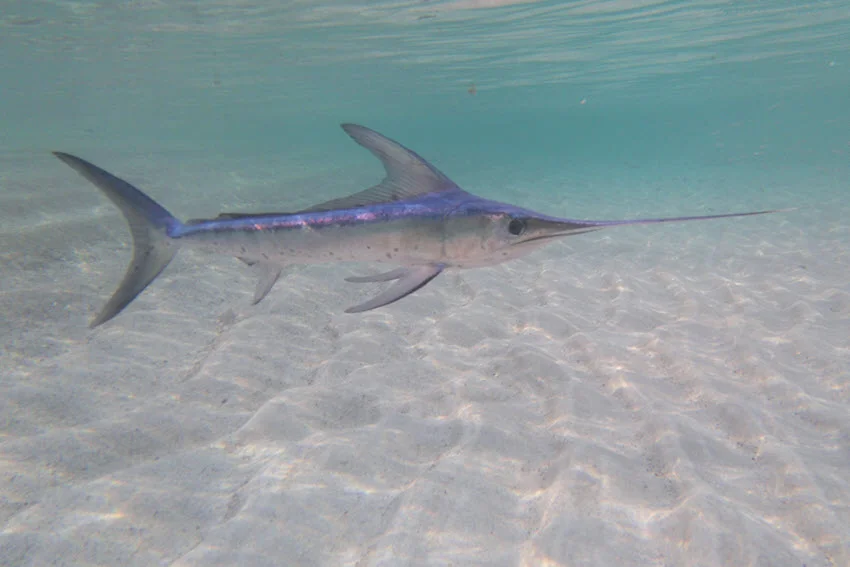
Swordfish is one of the most exciting catches in general, and if you are experienced enough in Galveston, this may be your lucky location to finally catch this fish. These majestic fish can grow up to 10 feet long and weigh over 500 pounds. Since Swordfish are migratory, they are usually found in the deeper, open waters of the Gulf of Mexico.
Swordfish are caught on giant squid, live baitfish, or deep-diving baits, with deep-fishing or night fishing techniques to reach the depths where these giants roam. These fish are not harmless; they strike powerfully and intensely, and if you think you are up to them, it is best to hunt them in the summer and fall months.
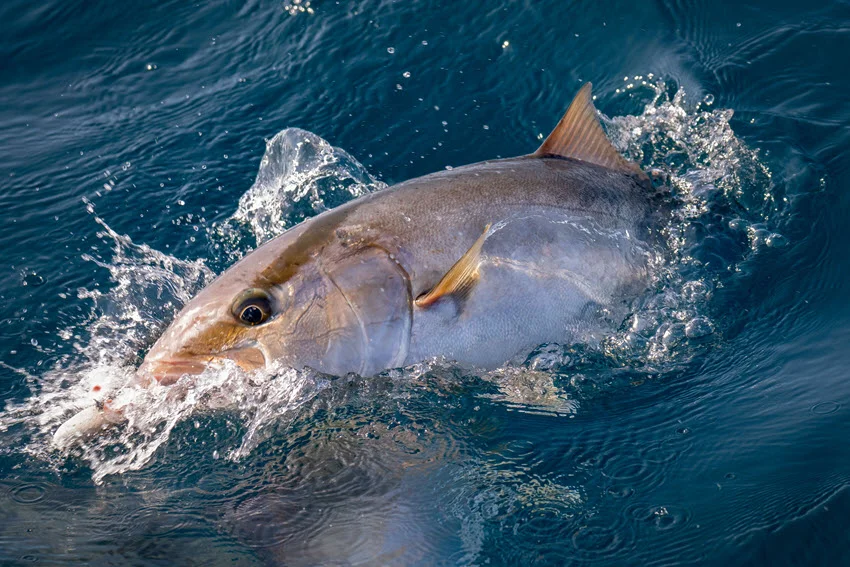
Amberjack is another large fish with which you can immortalize your fishing glory. Powerful fish that can grow up to 4 feet and weigh over 100 pounds, making them a formidable opponent for any angler. Amberjack usually lurks around offshore structures such as reefs, oil rigs, and wrecks, where it hides or hunts.
Like most larger species, Amberjack is often caught on live bait fish, jigs, or deep-diving baits, using techniques such as jogging or bottom fishing around offshore objects. Known for their strong running and hard fighting, these fish provide an exciting challenge, especially from spring to fall, when they migrate through the waters of Galveston.
Galveston is a treasure trove of unique and rich fishing spots in Texas, offering a diverse range of options. You can cast from the jetty and explore the depths of the tranquil estuaries. Every place is a gateway to an exciting fishing adventure. Let's get to know some of them better.
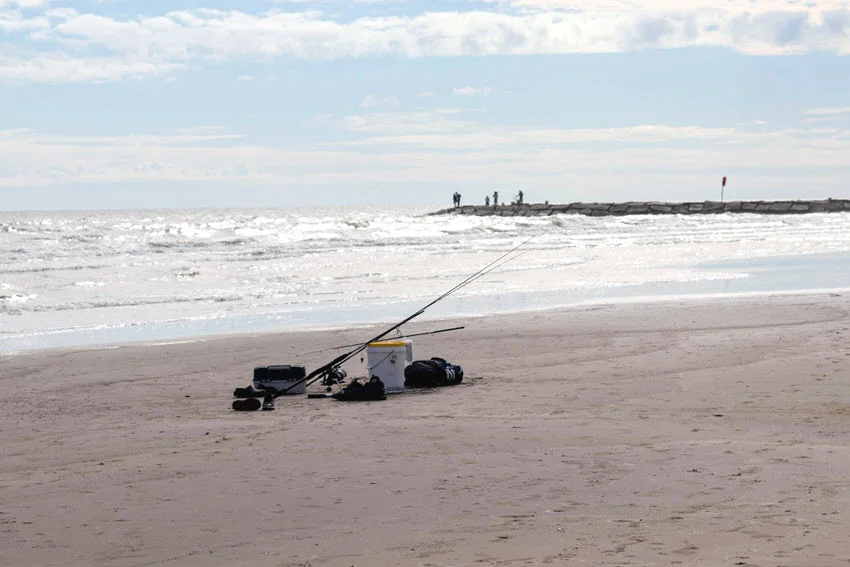
This beautiful structure, located at 9001 Seawall Blvd, is a hot spot that allows you to easily cast your line into the Gulf of Mexico and Galveston Bay. It carries the halo of a cult pier with plenty of fishing opportunities and incredible ocean gazing. The pier's design suits walkers, experienced anglers, and occasional fishermen.
Its robust structure and strategic position make it intriguing to everyone. At the same time, it provides access to various fishing conditions, from the deep blue to the shallow waters of the bay. The Galveston Fishing Pier is well-lit for night fishing and offers amenities that make it one of those places where you feel like you could live.
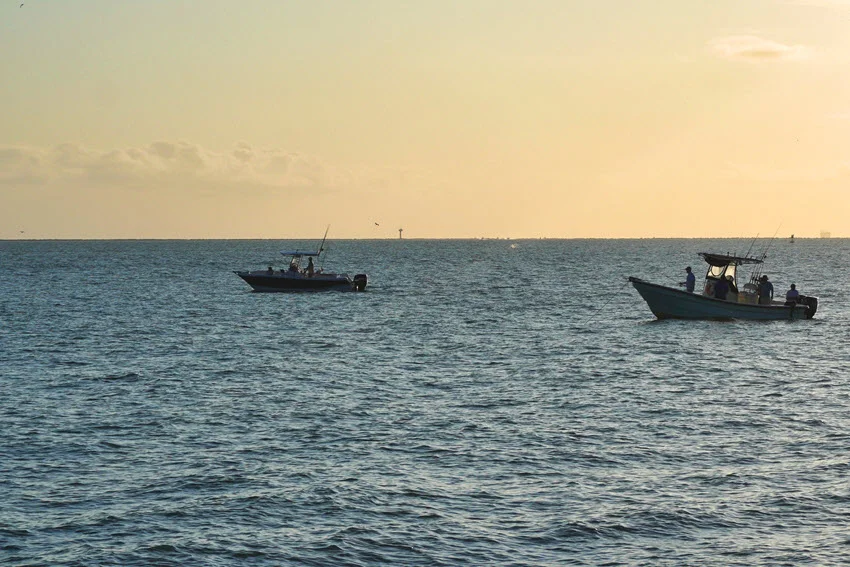
The Galveston Channel Piers are located relatively close to Galveston Harbor and are a hot spot for serious anglers seeking an exciting fishing experience. These rough structures are known for strong currents, which create a dynamic fishing environment where tidal currents and rocky outcrops encourage marine life.
You can cast from the shore or go out in a boat, and you will find a variety of targets, such as Redfish, Black Drum, and the elusive Sheepshead. With surfing and boat fishing options, this is one of those cool, urban spots that syncs the challenge of battling solid currents with the satisfaction of reeling in impressive catches.
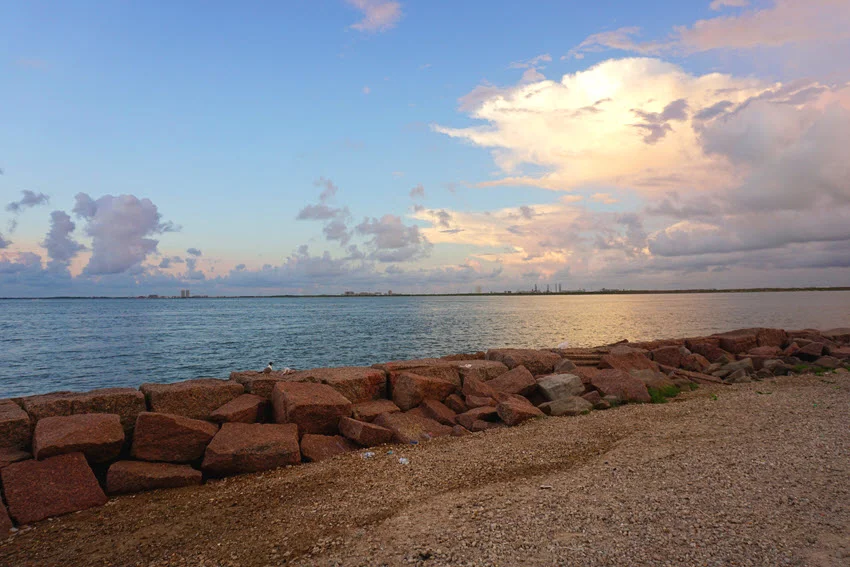
East Bay, located east of Galveston Island and accessible via Highway 87, is a calming and relaxing fishing spot. It is a shallow, spacious bay known for its wealthy fish population, including Flounder, Spotted Trout, and Redfish. It is prime for shallow water fishing and small boat or kayak adventures.
The water is clear, calm, and full of diverse underwater structures, creating perfect conditions for many fish species. It is straightforward to get to and with everything it offers. East Bay provides an ideal environment for anglers who want to enjoy a quiet day with cards always open to turn peace into passionate fishing action.
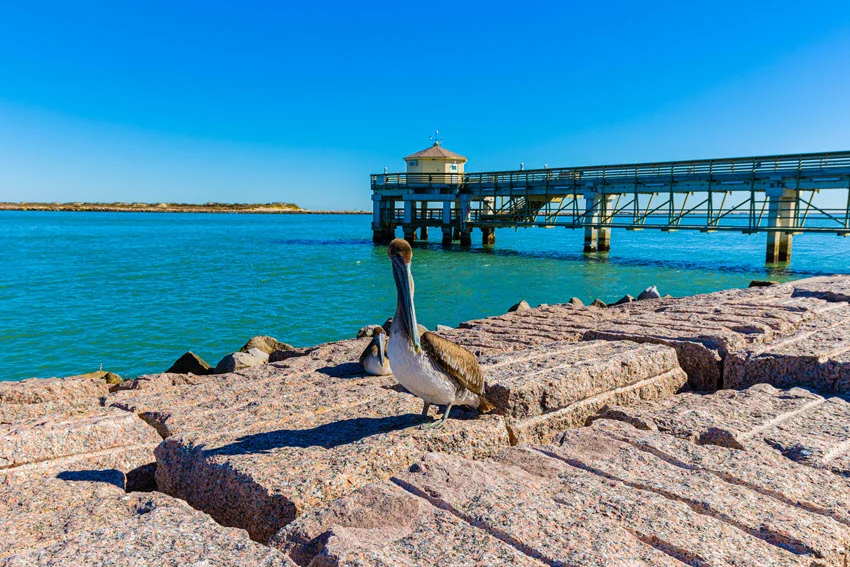
This park is a premier spot for Black Drum and Redfish fishing on Pelican Island. It is well-equipped and generally aimed at anglers. The park has convenient fish-cleaning stations and toilets, making it a comfortable and practical choice for all-day fishing.
Deep and shallow waters can be easily accessed, providing plenty of opportunities for productive fisheries and fishing experience and enough space to create conditions for an ideal fishing adventure tailored to your needs.
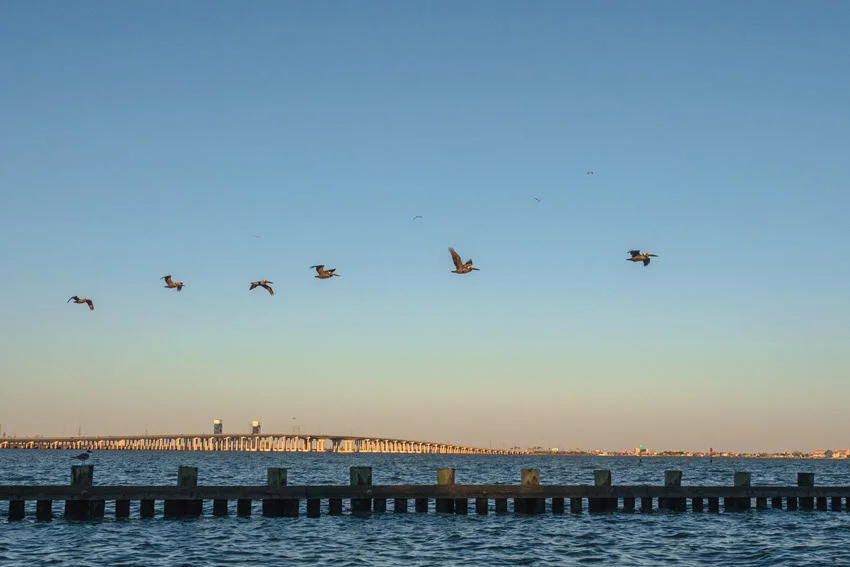
West Bay, located southwest of Galveston Island, is a diverse fishing paradise known for its combination of shallow and deeper waters. It includes extensive seagrass beds, submerged sandbars, and oyster reefs. During the warmer months, the grassy shallows teem with smaller fish, attracting larger predators.
On the other hand, deeper channels offer cooler water and are excellent places for trout fishing. West Bay offers several public boat ramps and parking spaces.
Galveston is rich in locations and fish, allowing you to practice various fishing techniques here. Whether you prefer to drift with the current, target the ocean floor, or cast for visible fish in shallow waters, you'll find a spot and technique to suit your style.
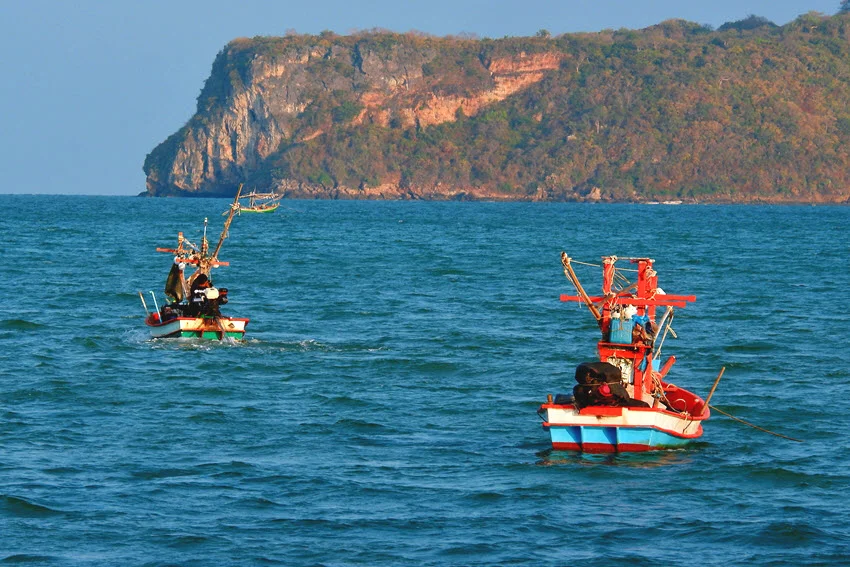
A simple and effective technique allows the boat to float with the current or wind during fishing while baits are attached to it. A highly effective method for covering large areas and targeting species such as Flounder, Speckled Trout and Redfish. It is possible to use both live or artificial baits and effectively explore different depths and structures without needing to move the boat constantly.
Drifting is an excellent technique for bays, estuaries, and coastal waters, where it helps locate fish congregating around reefs, sandbars, and grass flats. The essence lies in managing the speed and direction of the drifting boat, often with the help of a drift sock, and adjusting the bait's presentation.
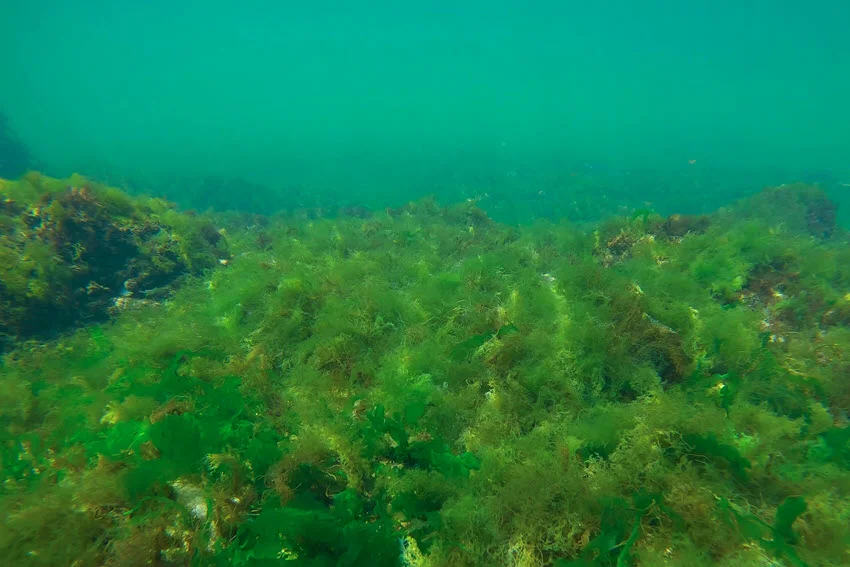
Although this technique has different approaches, bottom fishing involves lowering bait to the bottom of the sea to target fish that live close to the bottom, such as Flounder, Amberjack, Black Drum and Sheepshead. It is particularly effective around structures such as reefs, jetties, and wrecks, where fish are known to congregate in search of food and shelter.
Depending on the location and target type, light and heavy equipment can be used, and weights are essential. Anchoring or floating over productive spots and using a water-scanning device can increase your chances of a successful catch. The key to bottom fishing is to ensure your bait reaches the correct depth and adjust your settings to the fish's behavior and the current situation.
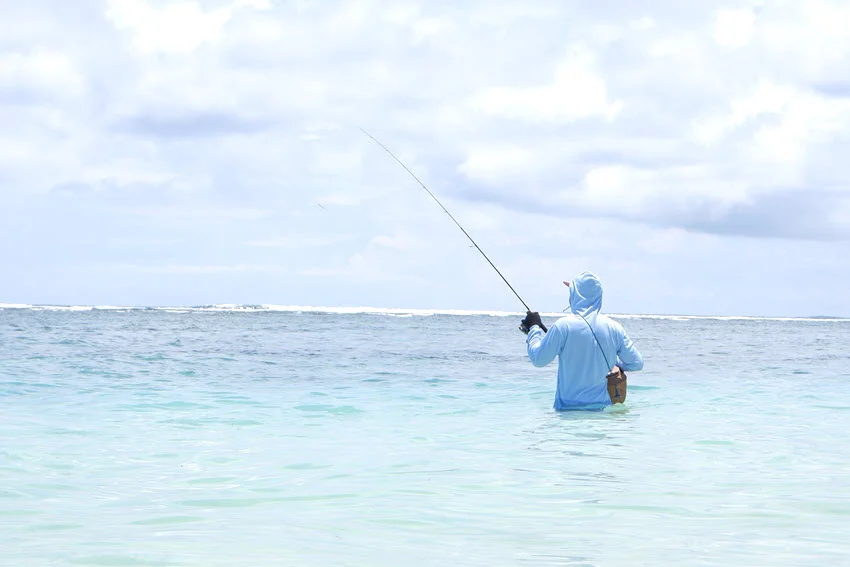
Sight fishing is an exciting technique that primarily requires precision and skill. Anglers visually locate the fish, usually in shallow water, and cast directly to it. You'll need plenty of clear, shallow water and polarized sunglasses to reduce water glare and improve visibility. After the fish has been spotted, the live bait or baits are accurately cast.
The popularity of this technique is growing every day because it offers something very attractive: a well-balanced relationship between skill and game. This is thanks to the fact that it requires sharp observation skills and accuracy, which makes it a worthy challenge for those who enjoy the fishing excitement of this type.
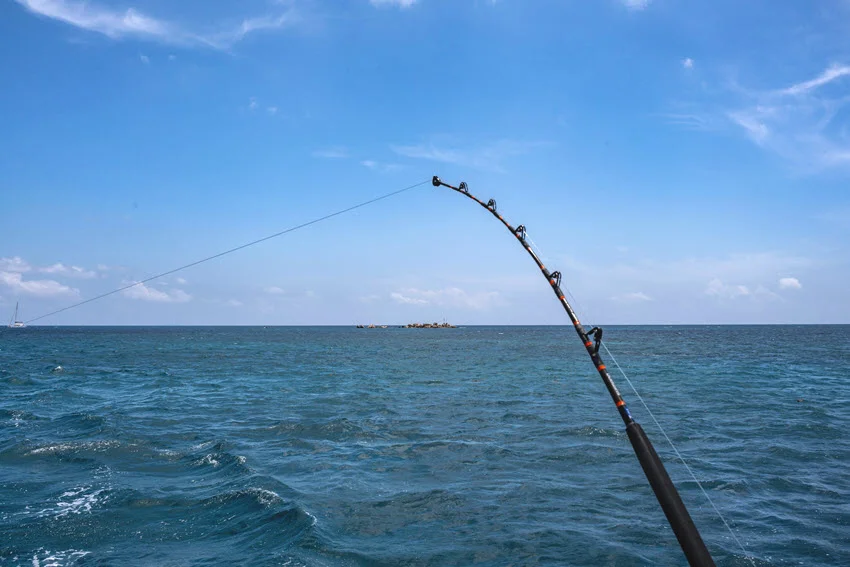
Trolling is a famous technique used in fresh and saltwater. Although it can be used in fresh and salt water, it is primarily used to catch fish that live in the open sea, that is, at great depths. It is very dynamic, tense, often tricky, and dangerous. It involves pulling bait or live bait behind a moving boat to target fast species such as King Mackerel, Tuna, and Mahi Mahi.
For successful trolling, it is vital to maintain a uniform boat speed to simulate the natural behavior of the prey as efficiently as possible. Trolling combines speed with strategy, and with a skilled angler, a rich catch is assured.
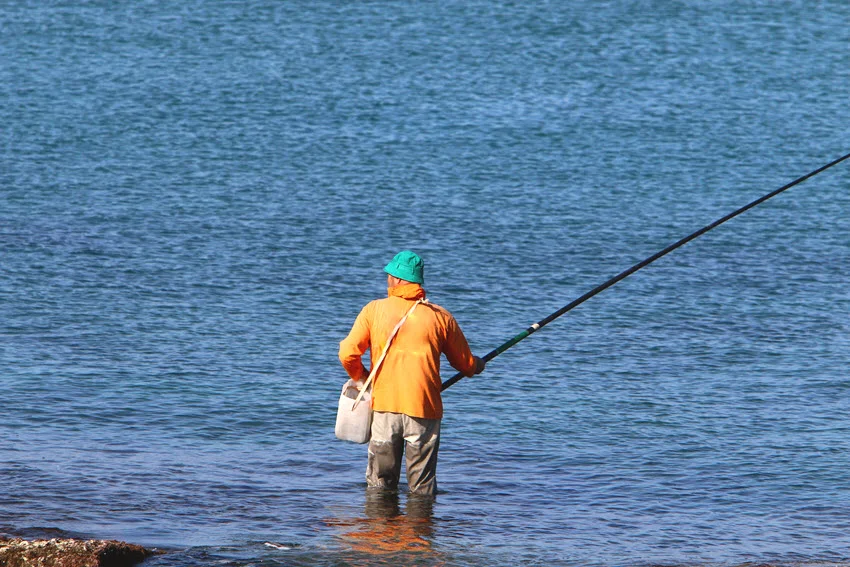
Wading is a form of fishing that involves walking in the water while using a classic rod and reel. The idea is to approach fish from a boat or shore in inaccessible areas. Wading is used in bays, estuaries, and shallow flats, where anglers target species such as Speckled Trout, Redfish, and Flounder. In addition to the standard equipment, you will need wading boots or a commode wading suit if you plan to wade deeper into the water.
The specificity of wading is the ability to interact with the environment from a great distance, allowing anglers to access productive fishing spots and cover the ground more effectively. You will need light tackle, often using soft plastics, live bait, or artificial lures. The technique offers a unique, immersive experience, combining stealth and precision to exploit the tremendous fishing opportunities in shallow waters.

Understanding fishing regulations in an area is crucial for protecting fish populations and ecosystems and promoting responsible angling practices.
Anglers Booking team
Before fishing in Galveston, it is essential to familiarize yourself with the local fishing regulations and follow them to have the most enjoyable experience possible. It will contribute to the promotion of sustainable fishing and the protection of marine resources. This primarily means complying with the basic rule that all anglers age 17 and older must possess a valid Texas fishing license, available online or at local Galveston retailers.
Also, be aware that throughout the year, the Texas Parks and Wildlife Department (TPWD) enforces catch and size limits for various species at certain times, as per its regulations, to prevent overfishing and maintain healthy fish populations and the overall ecosystem.
Sometimes, these regulations relate to permitted fishing equipment and techniques, so it is essential to follow the postings on the official website and stay informed of any seasonal closures or restrictions. Therefore, ensure you have all the necessary permits, as this will allow you to have more fun fishing and avoid potential fines.
If you've made it to the end, you've probably become hooked on fishing in Galveston and realized that it's more than just a sport, offering excellent opportunities to connect with nature. From bustling jetties and picturesque bays to tranquil bays and deep-sea waters, Galveston has a custom-made hug and greet with something for every angler.
So, grab your gear, check the weather forecast, and reserve the best fishing locations! While preparing and packing, motivate and encourage yourself by talking to us in the comment section! Write us your expectations before and experiences after, or anything you find helpful to share with us and fellow anglers! As always, we look forward to seeing you! Happy fishing!

The expert copywriters at Anglers Booking have meticulously crafted this article. Our dedicated team of writers provides valuable insights and information to enhance your angling experience.
Embark on unforgettable fishing adventures with us at Anglers Booking.
book your charterSeptember 29, 2025
September 25, 2025
September 21, 2025
September 21, 2025
September 16, 2025
September 21, 2025
September 8, 2025
September 5, 2025

You're now part of our exclusive community. Get ready for premium content and updates straight to your inbox.
close
Subscribe to our newsletter and receive a selection of cool articles every week.
Please enter a valid email address.

Be the first to know when we're back in action.
Please enter a valid email address.
Leave a Comment
Your email address will not be published. Required fields are marked *
Thank you for your comment! It has been submitted for review and will appear on the site shortly.